Kiwi capers
by Col Allison
Hunter 7
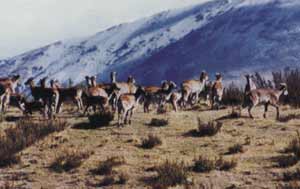
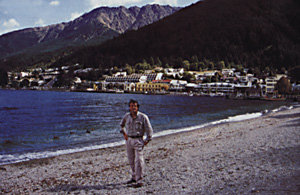
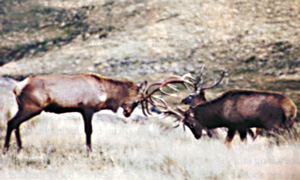 Some 5000ft below, overshadowed by Mt Cook, the ribbon-like streams of
the glacial-fed Murchison River tumbled through the moraine in the
headwaters of the valley. It was early May and on top of the Southern
Alps it was surprisingly warm with an intense glare off the snow and
ice.
Some 5000ft below, overshadowed by Mt Cook, the ribbon-like streams of
the glacial-fed Murchison River tumbled through the moraine in the
headwaters of the valley. It was early May and on top of the Southern
Alps it was surprisingly warm with an intense glare off the snow and
ice.
I made my way through a maze of greywacke bluffs, picking a trail past the overhangs very carefully. One fall and I was a goner. A big shingle fan barred the way, ending in an almighty drop to the floor of the hanging basin. I wasn’t going to run across this one, so pit-propped over the treacherous slate, using the butt of my custom M17 in .303 like a climbing staff.
I was terrified, but eventually stepped off the sliding grey sea onto solid rock and found myself in a good position overlooking a 1000-metre gut below the Cascade Glacier on the mighty chest of the Auguilles Rougues. With my Zeiss 8x30s, an indeterminate shape materialised from nowhere, well camouflaged. A lone bull Himalayan thar in splendid dark winter coat sporting a wind-whipped, copper ruff stood on the edge of a long crag looking down on his empire. He sported exceptional horns and looked magnificent. There was no other animal in sight.
To make a long story short, after a lot of creeping about I got within 200 metres and put the 4x Pecar on the bull’s chest and pulled the trigger. The blast ‘caroomed’ up and down the ravine and animals galore, hidden by crevices and caves and ledges, were spooked every which way. I missed with the first shot - it was further away than I thought - and the bull climbed straight towards the peaks. I missed again, rushing the shot, and when I settled down I let strip once more. The 150-grain slug landed in the boiler room.
It was a hard hit and the bull flinched once, missed its footing and plunged out from the vertical cliff. Dead for sure, its bear-like body cart-wheeled into space, smashing on a scree below and skating to rest like a skier wedged in a pile of rocks. It took the rest of the day, five weary hours, to climb down range and back up to where my prize lay.
By the time I staggered into the Malte Brun hut that night, incredibly with intact trophy horns, the moon was well up. I’d been climbing and hunting for 17 dangerous, back-breaking hours. But it had been a red-letter day. I’d just downed the biggest bull ever, with polished horns 12¼ inches long (31cm) and scoring 40¾ Douglas points, record-class.
I find it hard to believe as I reminisce (it seems like just yesterday) but this hunt took place almost 40 years ago. It was the end of New Zealand’s hunting heyday. Red stags were still colonising west coast valleys; chamois and thar had barely crossed the divide into South Canterbury ranges around Queenstown. Before it was a tourist mecca, Queenstown was home also to red, fallow and whitetail deer, plus legions of wild goats and geese, ducks and hares and rabbit - and one Col Allison, a 19-year-old expatriate Aussie hunting tragic out to shoot trophy animals of every species in the country.
The last time I hunted thar (not all that seriously since red stags were the primary target) I was choppered into the upper reaches of a West Coast valley in 1996. I bore an old friend, the custom ’98 Mauser I’d used in that other life as a .30-06 Springfield to kill truckloads of game in NZ and Australia.
I’d been ‘magnumised’ by Yank gun writers in the ’70s and the Oberndorf was now a 7mm Remington magnum, which stretched the ought-six out a further 100 yards. But it wasn’t going to down a whopping bull I’d spotted two-thirds up the range on the other side of the valley. Only slogging footwork would have done that and I wasn’t prepared to put in the hard yakka. The bull was no better than two or three others I’d taken years before. Many years before.
Without a doubt, bull thar are the toughest animals, kilo for kilo, in the country. I’ve been lucky in taking 15 bulls, with the .303, a .30-06 and .300 Norma Magnum and only three needed more than one shot. This was my fault, in all cases due to incorrect ‘guestimation’ of the lead on running animals I’d disturbed. Once the adrenalin flows through a big bull’s veins, they take some killing.
One of my points in this yarn is that calibres are relative, in NZ or anywhere else.
A survey of calibres in use in NZ in the 1960s revealed that almost every shooter used a .303 SMLE. This was a legacy of the British Empire, several wars, availability and cost of ammo. I was an extreme rarity in the Dominion then, a trophy hunter, when just about everybody else shot for meat. And I owned and shot several custom rifles. The most popular calibres then were the .308 Winchester (or 7.62 Nato, availability again), 7x57mm, .270 Win, .30-06 Springfield, .243 Win and the .22 Remington used by many cullers towards the end of the era. The .284 Win enjoyed great success initially as an all-rounder and still has its adherents.
Had a survey been done in Australia at the time, it would have been similar I’m sure; except we were well into necked down .303s - like the .25-303, .243-303, .270-303, unheard of in New Zealand. But few Aussies would have used their .222s on deer, while Kiwis shot a truckload of deer, plus plenty of chamois and thar to boot, with the little triple-deuce. I know three perennial chamois hunters in NZ who still use the .222 on these thin-skinned critters, but they’re expert marksman; one’s a farmer the others are both former government deer shooters.
Today, all these calibres are still in use among the throng across the Tasman. They take more than their fair share of fallow, red, rusa, sambar, Japanese sika, whitetail deer and wapiti, chamois and thar. But you’ll find many more modern rounds in the field such as the 7mm-08, .260 Rem, the odd .358 Win, plenty of .25-06s, 7mm Remington Magnums and .300 and Remington and Winchester Magnums, short, long and ultra. And that’s just in bolt actions, still the most popular tool on both side of the big ocean.
In the old days in the South Island and smaller areas of the north, long-range firearms came in very handy. Much of the game was found on the tops, living above the bushline at up to 4000ft. Here in snowgrass tussock basins and around tarns (small alpine lakes), lived the herds that produced the best trophies. Then came helicopter squads trapping for deer farms and shooting for the meat industry. In a short few years, the high-altitude populations of deer (and even chamois and thar) crashed. The survivors hug the bushline, often only venturing out on the tops at dusk and dawn when you have to be quick to snipe one. Few deer are out and about on the tops in daylight these times. The sound of a chopper motor still terrifies stags, bulls and bucks.
New Zealand has some of the most impenetrable timber areas of the Southern Hemisphere. No amount of fancy shooting will earn you a trophy, mat or feed unless you can stalk in on a target in heavy cover. This is one reason why sika, whitetail, sambar and rusa deer have always been such premier trophies. The other is there are not as many of them as some breeds, though sika are now in good numbers. These are extremely wary critters living in dense bushland, in some instances in end-over-end country. You have to be fit, savvy and knowing of their ways to even see a trophy head most times.
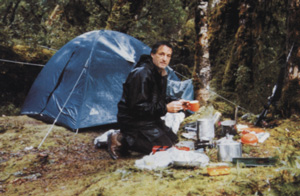
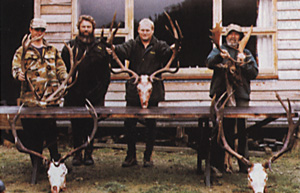
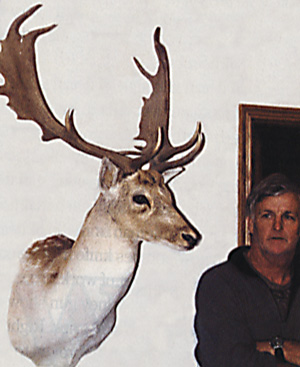 In four trips to New Zealand after sika I only managed one decent
eight-point head, though I shot two lesser but equally hard-won racks,
a six- and a seven-pointer (with a 6mm Remington, a .30-06 and 7mm Rem
Magnum, respectively). All were one-shot kills, the 6mm shot the most
spectacular.
In four trips to New Zealand after sika I only managed one decent
eight-point head, though I shot two lesser but equally hard-won racks,
a six- and a seven-pointer (with a 6mm Remington, a .30-06 and 7mm Rem
Magnum, respectively). All were one-shot kills, the 6mm shot the most
spectacular.
I’d heard the buck braying like a donkey in a creek bed but couldn’t for the life of me pin it down. It would stop and characteristically circle, seemingly playing games with me. I was sure it had been pegged, so I backed off, climbed to the top of the little gut and started pelting rocks into the creek bed. Eventually the stag could stand it no more and bolted - straight through an open glade where I nailed it with a fine running shot at less than 200 yards.
One year a bloke and his dog, camped in the same hut as me in Jap Creek in the Kaipo Stream, bailed a mighty eight-point sika at first light. He had an easy shot with a .270 from memory and was in and out with a huge head in just a few hours. I was still there a week later, trying hard with my 7mm mag.
In a year shooting whitetails for a living as a meat-shooter on Stewart Island (SI), I shot half a dozen representative heads and one that made the record books. I picked up the right cast antler of another that would have made the US records. It was huge with every tine as long as a bayonet. I gave it to the local museum. Interestingly, in those years perhaps 30 hunters visited the island each season.
Last year more than 3000 hunters - many of them Australians - made the trip after the timid little Virginians. I know all this because I was asked by a New Zealand deerstalking group to send my record whitetail head - or its photo - and memories of the heydays of the herd for a Top 50 exhibition being held in the south. The idea was to show the potential of the whitetail on SI, now under threat from National Parks extermination policies. That old 1080 bogey has raised its head in the land where killing off ‘pest’ deer is a favourite tool of government.
I tried everything in my time against whitetail deer. I pushed 220 Norma pills in my .30-06 hoping to cut through the brush. In a series of tests with 150-, 180- and 220-grain slugs I found any decent twig would deflect them all. Certainly, I shot no more deer with the 220-grainers than I did with the 150s, which are the most spectacular killers in 30 calibres against light-skinned game. The same applies with 7mm, actually. These mid-range slugs open up fast and maximise damage. The heavier slugs are designed for bigger, thicker-skinned bite-back critters.
Forty years ago I decided there was not an animal in the land that needed more power to kill than a 180-grain .30-06. And this was reserved for the wapiti, which is really no harder to kill than a big red stag anyway, all things being equal. At the end of the day, regardless of what you use, it’s where the bullet ends up that really counts.
Six shots in the rear of a wapiti with a .375 Holland and Holland will bring it down by weight of lead alone - but not humanely. One 150-grain shot from a .270 Winchester or a 160-grain .280 Remington in the boiler room and that wap is out for the count. The great calibre debate really boils down to this simple equation: hit the animal in the heart or lungs or break the spine and it’s yours. You owe it to the quarry to kill it outright in the most humane manner.
A flinched shot from a rifle too heavy for you to use successfully is not the way to go. A vicious recoiler with a muzzle blast like a .50 cal tank-killer that scares you witless is not conducive to pin-point accuracy. This is why I tend to hunt with smaller, tack-holing calibres against deer as I age - in Australia and New Zealand.
The state of the game
Dudley Nicol, the veteran Canberra-based deer hunting guide, has been
taking parties of Aussies and others to New Zealand for more than 30
years. He says anyone contemplating a trip to a new area should call a
Department of Conservation (DOC) office and ask for an animal density
rating.
In most cases the reports will come back ‘Low’ or ‘Very Low’. Basically this means that animal density is lower than in the Australian bush. The terrain, or alternatively the overgrown vegetation, makes it harder to hunt so you need to do your homework. Don’t assume the animals are going to be in the same place they were last year. Every hunter needs to be extremely cautious of helicopter transport and should check the final destination thoroughly before takeoff. Chopper pilots get their weekly wage regardless of your result. In many cases you are just an added bonus.
While the tramper popular venues are well maintained, many of the popular hunting venues have regressed to thick undergrowth - especially in Fiordland where wapiti and red deer trails up the ridges have disappeared. You will hear reports of increased red deer numbers away from helicopter depots because it is becoming increasingly difficult to run commercial operations. This will not be yielding trophy animals, as they take time to mature and many of these areas are hunted periodically.
The widespread use of 1080 has lead the American authorities to closely scan for traces of the poison in export shipments. As a result the ‘wild and free’ venison industry has become selective. Many DOC offices have engaged professional hunters to target thar and goat numbers. Hokitika on the West Coast for example has three fulltime cullers working on the local river systems. These guys are experienced and tough, spending a lot of time in the field. The Bay of Island, Picton and other areas on the North Island have goat cullers either full- or part-time. They are using Judas goats (radio collars) but even then have a battle with goat numbers.
Chamois numbers are down and I suspect have never been lower. You have to work extremely hard to find trophy animals. The best hunting is on the West Coast between
Greymouth and Haast. In the North, it is beyond Hamner Springs, through the Kaikouras and towards Nelson. Even the chopper operators freely admit that numbers are down. There are still smatterings in the Wilberforce, Mathias, Cope, Rangitata, round Wanaka and Mount Aspiring but they are bonus animals and at best unpredictable.
On the red deer front, in the past ten years two million animals have either been live-captured or shot for the venison market. So, if you’re going to be lucky then generally it’s in an area where they are afforded some protection.
On the thar front, it is even difficult to get a constant figure from DOC on just how many thar there are left on the South Island. I have heard figures as low as 5300. Hopefully these are not correct. Unlike Alaska where you can only hunt the day after you land a light aircraft at your camp-site, in New Zealand these animals are constantly hunted by chopper. There are a lot of moral issues here but as long as the holy American dollar rules the skies, this type of trophy hunting will flourish.
International hunters are increasing every season and are welcomed by a hungry tourist industry and a government eager to wipe out these animals. In 2002 they had a DOC-endorsed ‘Wild Thar’ capture period, which permitted the game ranches to stock their paddocks, a DOC cull reduction of thar numbers program and an NZDA hunt to achieve the same end. The thar somehow manage to sustain this pressure but the size of herds and the concentrations definitely suffered.
Captions
Image 1: A mixed bunch of Himalayan thar caught
napping by Allison on a sunny slope of the Southern Alps. It doesn’t
happen very often.
Image 2: Down memory lane. Col about to go
hunting takes a break at his former home shores on Lake Whakatipu in
Queenstown, New Zealand, home of red, fallow and whitetail deer.
Image 3: A wapiti and a wapiti-red deer cross
testing their mettle as the rut approaches while a younger animal looks
on.
Image 4: Col, thoroughly wet on a Fiordland
wapiti hunt, is not worried about rifle calibres, but calories.
Image 5: An Aussie contingent with a big haul
from a game ranch on the South Island - taken with everything from a
7x57 to a .300 Win Magnum.
Image 6: Canberra deerstalking guide Dudley
Nicol admires a top trophy fallow, a .22 pointer, from the South Island
of New Zealand. Thin-skinned animals like this are easy meat for
calibres in the 6mm to .270 range, using 100- to 130-grain projectiles.
